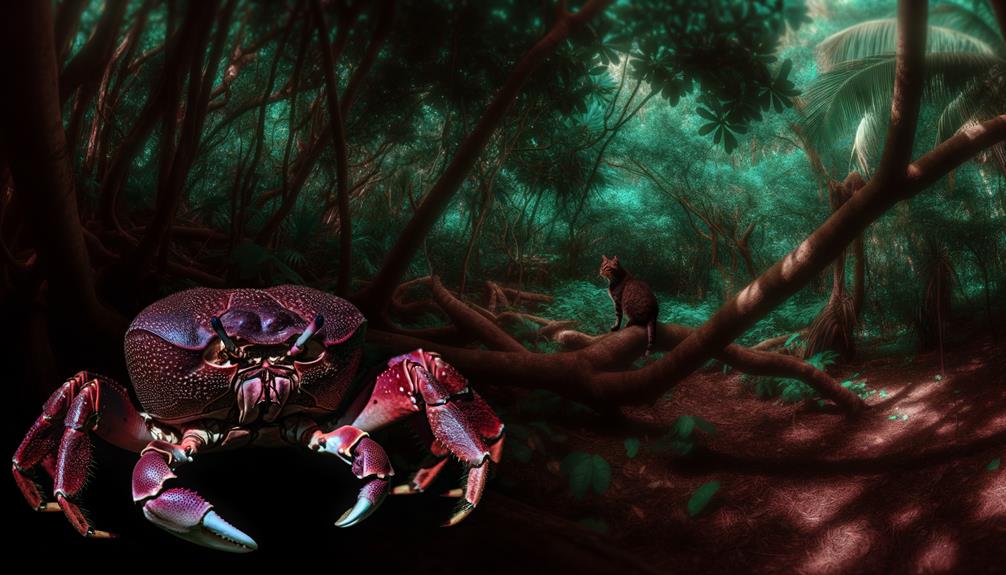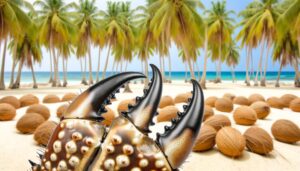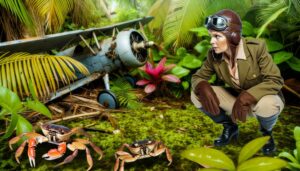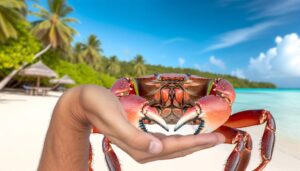Do Coconut Crabs Go Through a Metamorphosis Process?
There is scant scientific evidence supporting the notion that coconut crabs prey on cats. Coconut crabs primarily consume fruits, nuts, and carrion and exhibit opportunistic scavenging behavior.
While they possess powerful claws that can break open hard-shelled prey and have been observed hunting small animals, documented instances of coconut crabs attacking cats are virtually nonexistent. Most reports likely stem from anecdotal accounts or misconceptions.
Experts agree that interactions between coconut crabs and cats are rare. For those interested in the predatory behaviors and ecological impact of these formidable crustaceans, further investigation offers valuable insights.

Key Takeaways
- There is sparse evidence supporting claims of coconut crabs preying on cats.
- No direct scientific evidence exists for coconut crabs attacking cats.
- Rare interactions between coconut crabs and cats are suggested by prevailing scientific consensus.
- Behavioral misinterpretations may contribute to myths of coconut crabs eating cats.
- Lack of credible scientific documentation supports the rarity of cat predation by coconut crabs.
Understanding Coconut Crabs
Coconut crabs, known scientifically as Birgus latro, are the largest terrestrial arthropods on Earth. They can reach up to one meter in leg span and weigh up to 4.1 kilograms. Their exoskeleton provides significant protection, while their powerful claws can exert forces up to 3300 newtons, enabling them to crack open coconuts, their primary food source.
Coconut crabs exhibit a nocturnal behavior, emerging at night to forage. They possess highly developed olfactory organs, which help them locate food over long distances. These crabs are known to be omnivorous scavengers, consuming fruits, nuts, seeds, and carrion.
Their unique adaptations and feeding habits make them a subject of interest in behavioral ecology and arthropod physiology studies.
Habitat and Distribution
Primarily dwelling in coastal areas and offshore islands in the Indian and Pacific Oceans, Birgus latro flourishes in environments that offer both terrestrial and arboreal elements. They're typically found in regions with dense vegetation, which provides ample cover and climbing opportunities.
Coconut crabs prefer areas with sandy or rocky substrates that facilitate burrowing. These crustaceans are nocturnal, seeking shelter in burrows or crevices during the day and emerging at night to forage.
Their distribution spans from the Andaman and Nicobar Islands to parts of Polynesia, including the Cook Islands and the Gambier Islands. Studies show that their presence is closely linked to the availability of coconut trees, which provide both food and habitat, thus playing a significant role in influencing their geographic range.
Physical Characteristics
Coconut crabs exhibit substantial size and strength, commonly reaching up to 4 kg in weight and a leg span of about 1 meter.
Their unique claw structure, with one claw typically larger and stronger than the other, allows them to exert significant force, necessary for cracking open coconuts.
These physical attributes play an essential role in their feeding behavior and potential interactions with other animals.
Size and Strength
With a leg span that can exceed three feet, the coconut crab's formidable size, combined with its powerful pincers, underscores its reputation as the largest terrestrial arthropod. Weighing up to nine pounds, these crabs exhibit immense physical strength, capable of exerting a force of up to 740 pounds per square inch with their pincers. This strength allows them to crack open coconuts, their primary food source, and manipulate heavy objects in their environment.
Their robust exoskeleton provides structural support and protection, enabling them to climb trees and navigate rugged terrain effectively. Such physical characteristics make coconut crabs well-adapted to their habitat, allowing them to dominate the ecological niche they occupy. Their size and strength are pivotal to their survival and behavior.
Unique Claw Structure
Their formidable pincers, an extension of their unique claw structure, demonstrate a remarkable adaptation that enhances both their predatory and defensive capabilities. Coconut crabs possess chelae that exhibit significant mechanical strength. These claws can exert a force of up to 3,300 newtons, making them exceptionally powerful among terrestrial arthropods. This strength allows them to crack open hard exteriors, such as coconuts and smaller prey.
| Feature | Description | Function |
|---|---|---|
| Chelae | Large, robust pincers | Gripping, crushing |
| Propodus | Enlarged segment | Structural support |
| Dactylus | Movable part of the claw | Manipulation |
| Flexor Muscle | Powerful muscle within chelae | Force generation |
| Exoskeleton | Hardened outer layer | Protection, rigidity |
This anatomical configuration underscores their capacity to interact dynamically with their environment.
Diet and Feeding Habits
Coconut crabs primarily consume natural food sources, including fruits, nuts, and carrion.
As opportunistic scavengers, they exploit a wide range of available organic material.
Instances of predatory behavior have been documented, highlighting their capacity to capture and consume live prey.
Natural Food Sources
Despite their intimidating appearance, coconut crabs primarily consume a diet of fruits, nuts, and seeds. These terrestrial crustaceans exhibit specialized feeding habits that reflect their adaptation to island ecosystems. Their robust claws enable them to crack open hard-shelled items and access the nutritious contents within. Studies have documented their preference for the following natural food sources:
- Coconuts – a staple in their diet, providing essential fats and nutrients.
- Breadfruit – another common source of carbohydrates and vitamins.
- Pandanus fruit – offers a rich supply of vitamins and minerals.
- Seeds and nuts – diverse in type, supplying proteins and essential fats.
Their diet underscores a well-adapted strategy for survival in nutrient-scarce environments.
Opportunistic Scavengers
In addition to their primary diet, coconut crabs often scavenge for food, exploiting various available resources to maximize their energy intake. They consume fallen fruits, decaying plant matter, and dead animals, demonstrating significant dietary flexibility.
Studies have shown that coconut crabs will eat carrion, which includes the remains of birds and other small animals. This scavenging behavior allows them to survive in diverse environments with fluctuating food availability.
Observations indicate that their keen sense of smell aids in locating food sources, making them efficient scavengers. Moreover, their powerful claws enable them to break open hard-shelled items like coconuts and other nuts, enhancing their ability to access a wide array of nutritional options within their habitats.
Predatory Behavior Instances
While coconut crabs are adept scavengers, they also exhibit predatory behavior, actively hunting live prey such as insects, small mammals, and even birds. Their diet isn't limited to plant matter and carrion. Observations have documented their ability to capture and consume various live organisms.
Key instances of their predatory behavior include:
- Insect Consumption: Coconut crabs commonly hunt insects, providing a substantial protein source.
- Small Mammal Predation: They've been observed preying on small mammals, although such instances are relatively rare.
- Bird Hunting: Reports exist of coconut crabs capturing and killing birds, particularly ground-nesting species.
- Crustacean Predation: They often prey on other crustaceans, such as smaller crabs, enhancing their dietary diversity.
This evidence underscores the coconut crab's versatility in its feeding habits.
Predatory Behavior
Coconut crabs display a sophisticated predatory behavior that involves using their strong claws to capture and dismember various prey. Their claws exert a force of up to 3,300 newtons, allowing them to break open hard-shelled animals like mollusks and crabs.
They utilize sensory hairs to detect chemical cues in their surroundings, helping in locating food sources. Upon capturing prey, they carefully disassemble it, consuming both soft tissues and exoskeletons.
This behavior is fueled by their varied diet, which includes live prey, carrion, and plant material. Their nocturnal activity pattern further boosts their predatory efficiency, reducing competition and predation risk.
Coconut crabs' robust predatory strategies guarantee their survival and ecological dominance in their natural habitats.
Interaction With Other Animals
Coconut crabs interact with various animals primarily through predatory behavior and competition for resources. Studies indicate that their natural diet includes fruits, nuts, and carrion, though they've been observed preying on birds and other small animals.
This evidence suggests that while their primary diet isn't carnivorous, they exhibit opportunistic feeding behaviors.
Predatory Behavior Observed
Researchers have occasionally documented coconut crabs preying on a variety of animal species, showcasing their opportunistic feeding habits. These crustaceans exhibit complex predatory behavior, often targeting vulnerable or immobilized prey. Observations highlight the following interactions:
- Birds: Coconut crabs have been seen attacking and consuming seabirds, particularly during nesting periods.
- Rodents: There are instances of coconut crabs preying on small mammals like rats, utilizing their powerful claws to immobilize them.
- Invertebrates: They frequently prey on other invertebrates, including smaller crabs and insects, contributing to their diverse diet.
- Carrion: Coconut crabs are known to scavenge on dead animals, effectively recycling nutrients within their ecosystem.
These behaviors underline their adaptability and ecological role as both predators and scavengers.
Natural Diet Preferences
Frequently feeding on a wide array of organisms, these omnivorous crustaceans exhibit a highly varied diet that includes fruits, nuts, and animal matter. Coconut crabs, Birgus latro, primarily consume plant-based materials, but their dietary flexibility allows for opportunistic feeding on other animals. They've been documented scavenging carrion and preying on small vertebrates and invertebrates.
Studies indicate that their strong pincers enable them to crack open hard-shelled items, such as coconuts and other nuts, essential for their nutrition. Interaction with other animals often revolves around scavenging rather than active predation. While they can potentially prey on larger animals, including birds, evidence of coconut crabs targeting domestic animals like cats remains anecdotal and not scientifically substantiated.
Myths and Legends
Despite popular tales and sensational stories, evidence supporting the claim that coconut crabs prey on cats remains sparse and largely anecdotal. Many myths and legends have emerged over time, but they often lack rigorous scientific backing.
To better understand these narratives, consider the following points:
- Historical Accounts: Reports of coconut crabs attacking larger animals often rely on unverified anecdotes.
- Media Exaggeration: Sensationalist media coverage can magnify isolated incidents, creating a distorted perception.
- Behavioral Misinterpretations: Observations of crab behavior may be misinterpreted or exaggerated when shared informally.
- Lack of Direct Evidence: Scientifically documented cases of coconut crabs preying on cats are virtually non-existent.
Evidence of Cat Encounters
While myths and legends abound, verifiable encounters between coconut crabs and cats remain exceedingly rare in scientific literature. Researchers have documented coconut crabs (Birgus latro) preying on various animals, primarily small birds and invertebrates. However, there's scant empirical evidence supporting claims that these crabs actively hunt or consume domestic cats (Felis catus).
Anecdotal reports do exist, but they lack rigorous scientific validation and are often based on circumstantial observations. Field studies and controlled experiments have yet to confirm any direct predation events involving coconut crabs and cats. Consequently, the prevailing scientific consensus suggests that such interactions, if they occur, are exceptional rather than commonplace.
Further research is necessary to substantiate or refute these anecdotal claims.
Expert Opinions
Leading experts in marine biology and zoology generally agree that documented predation of domestic cats by coconut crabs is highly improbable. This conclusion derives from several critical observations:
- Dietary Preferences: Coconut crabs primarily consume fruits, nuts, and carrion rather than live prey, making them unlikely predators of cats.
- Behavioral Evidence: Studies indicate that coconut crabs are scavengers and opportunistic feeders, not active hunters.
- Geographic Distribution: Coconut crabs inhabit tropical regions, often isolated from areas with significant domestic cat populations.
- Recorded Incidents: There's a lack of verifiable incidents or credible scientific documentation of coconut crabs attacking or consuming domestic cats.
These points underscore the consensus among scientists that coconut crabs pose minimal threat to domestic cats.
Protective Measures for Pets
Pet owners in tropical regions can implement several evidence-based strategies to safeguard their cats from potential wildlife threats, including coconut crabs. One effective measure is to secure pet enclosures with durable, crab-resistant materials.
Utilizing elevated platforms can also reduce the likelihood of crab encounters, as these arthropods are less adept at climbing.
Ensuring indoor confinement during nocturnal hours, when coconut crabs are most active, further minimizes risk.
Additionally, regular inspection of the property for crab burrows and potential attractants, such as food waste, can deter crabs from entering areas frequented by pets.
Conservation Status
Understanding the conservation status of coconut crabs is essential for comprehending their ecological impact and the measures required to preserve both local wildlife and domestic pets. Coconut crabs, Birgus latro, are listed as Data Deficient by the IUCN Red List. However, they face threats that could impact their populations significantly.
Major threats include:
- Habitat Loss: Deforestation and urban development reduce their natural habitat.
- Overharvesting: They're hunted for their meat, leading to population declines.
- Climate Change: Rising sea levels and temperature fluctuations affect their habitat.
- Pollution: Marine and terrestrial pollution impact their health and reproductive success.
Conservation efforts must address these threats to guarantee the species' survival and maintain ecological balance.
Final Thoughts on Safety
Ensuring the safety of both coconut crabs and potential domestic pet interactions requires a thorough understanding of their behavior and habitat needs. Coconut crabs are primarily nocturnal and inhabit coastal regions with dense vegetation. They possess strong pincers capable of causing significant injury if threatened. However, there's limited evidence suggesting they actively hunt domestic pets, including cats.
To reduce risk, pet owners in areas inhabited by coconut crabs should supervise pets, especially at night. Keeping pets indoors after dark and securing outdoor spaces can mitigate potential encounters. By respecting the natural behavior and environment of coconut crabs, humans can coexist safely with these remarkable creatures while ensuring their pets' well-being.
Conclusion
To sum up, while the coconut crab's impressive power and hunting behavior bring to mind legendary creatures, scientific evidence indicates they seldom endanger household pets such as cats.
Their diet mainly comprises plant matter, carcasses, and tiny creatures, in line with their ecological function. Specialists advise straightforward protective measures to guarantee pet safety.
As these beings encounter preservation obstacles, comprehending their conduct and environment can promote cohabitation, akin to honoring the limits of nature's colossal beings.






